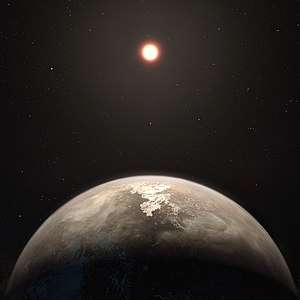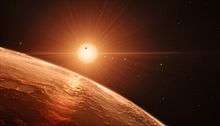Ross 128 b
| Exoplanet | List of exoplanets | |
|---|---|---|
 | ||
| Parent star | ||
| Star | Ross 128 | |
| Constellation | Virgo | |
| Right ascension | (α) | 11h 47m 44.3974s |
| Declination | (δ) | +00° 48′ 16.395″ |
| Apparent magnitude | (mV) | 11.13 |
| Distance | 11.03 ± 0.02 ly (3.381 ± 0.006 pc) | |
| Spectral type | M4V | |
| Mass | (m) | 0.168 (± 0.017) M☉ |
| Radius | (r) | 0.1967 (± 0.0077) R☉ |
| Temperature | (T) | 3192 (± 60) K |
| Metallicity | [Fe/H] | -0.02 (± 0.08) |
| Age | 9.45 (± 0.60) Gyr | |
| Physical characteristics | ||
| Mass | (m) | ≥ 1.35 (± 0.02) [1] M⊕ |
| Stellar flux | (F⊙) | 1.38 ⊕ |
| Temperature | (T) | 213 - 301 K |
| Orbital elements | ||
| Semi-major axis | (a) | 0.0496 (± 0.0017) AU |
| Periastron | (q) | 0.0475 (± 0.0031) AU |
| Apastron | (Q) | 0.0511 (± 0.0031) AU |
| Eccentricity | (e) | 0.036 (± 0.092) |
| Orbital period | (P) | 9.8658 (± 0.0070) d |
| Discovery information | ||
| Discovery date | 15 November 2017 | |
| Discoverer(s) | Xavier Bonfils | |
| Discovery method | Radial velocity | |
| Discovery status | Confirmed | |
| Other designations | ||
FI Virginis b, FI Vir b, G 010-050 b, GCTP 2730 b, GJ 447 b | ||
| Database references | ||
| Extrasolar Planets Encyclopaedia | data | |
| SIMBAD | data | |
| Exoplanet Archive | data | |
| Open Exoplanet Catalogue | data | |
Ross 128 b is a confirmed Earth-sized exoplanet, likely rocky, orbiting within the inner habitable zone of the red dwarf Ross 128, at a distance of about 11 light-years from Earth;[2] Ross 128 b is the second closest known exoplanet to our solar system after Proxima Centauri b. The exoplanet was found using a decade's worth of radial velocity data using the European Southern Observatory's HARPS spectrograph (High Accuracy Radial velocity Planet Searcher) at the La Silla Observatory in Chile. Ross 128 b is the nearest exoplanet around a quiet red dwarf, and is considered one of the best candidates for habitability. The planet is only 35% more massive than Earth, receives only 38% more sunlight, and is expected to be a temperature suitable for liquid water to exist on the surface, if it has an atmosphere.[1]
According to the Exoplanets Channel, Ross 128 b is likely to be rocky because all the exoplanets discovered so far that have fewer than 4 Earth masses, have proved to be rocky.[3]
The planet does not transit its host star, which will make atmospheric characterization very difficult until larger telescopes like the European Extremely Large Telescope or the James Webb Space Telescope come online.[1]
Characteristics
Mass, radius, and temperature
Due to it being discovered by the radial velocity method,[4] the only known physical parameter for Ross 128 b is its minimum possible mass. The planet is at least 1.35 M⊕, or 1.35 times the mass of Earth (about 8.06×1024 kg). This is slightly more massive than the similar and nearby Proxima Centauri b, with a minimum mass of 1.27 M⊕. The low mass of Ross 128 b implies that it is most likely a rocky Earth-sized planet with a solid surface.[5] However, its radius, and therefore its density, is not known as no transits of this planet have been observed. Ross 128 b would be 0.5 R⊕ (Earth radii) for a pure-iron composition and 3.0 R⊕ for a pure hydrogen-helium composition, both implausible extremes. For a more plausible Earth-like composition, the planet would need to be about 1.10 R⊕ - i.e., 1.1 times the radius of Earth (approximately 7008 km). With that radius, Ross 128 b would be slightly denser than Earth, due to how a rocky planet would become more compact as it increases in size. It would give the planet a gravitational pull around 10.945 m/s2, or about 1.12 times that of Earth.[1]
Ross 128 b is calculated to have a temperature similar to that of Earth and potentially conducive to the development of life.[4] The discovery team modelled the planet's potential equilibrium temperature using albedos of 0.100, 0.367, and 0.750. Albedo is the portion of light that is reflected instead of absorbed by a celestial object. With these three albedo parameters, Ross 128 b would have a Teq of either 294 K (21 °C; 70 °F), 269 K (−4 °C; 25 °F), or 213 K (−60 °C; −76 °F). For an Earth-like albedo of 0.3, the planet would have an equilibrium temperature of 280 K (7 °C; 44 °F), about 8 degrees Kelvin lower than Earth's average temperature.[4] The actual temperature of Ross 128 b depends on yet-unknown atmospheric parameters, if it has an atmosphere.[1]
In 2018, astronomers, based on near-infrared, high-resolution spectra (APOGEE Spectra), determined the chemical abundances of several elements (C, O, Mg, Al, K, Ca, Ti, and Fe) present in Ross 128 b, and further, that the exoplanet has near solar metallicity, contains a mixture of rock and iron and is a "temperate exoplanet in the inner edge of the habitable zone".[6][7]
Orbit and rotation
Ross 128 b is a closely orbiting planet, with a year (orbital period) lasting about 9.9 days.[1][4] Its semi-major axis is 0.0496 AU (7.42 million km). According to some models of the planet's orbit, its orbit is quite circular, with an eccentricity of around 0.03, but also with a large error range as well. However, if all the orbital models are brought together then the eccentricity is higher at about 0.116, and again this is subject to a large error range. Compared to the Earth's average distance from the Sun of 149 million km, Ross 128 b orbits 20 times closer. At that close distance from its host star, the planet is most likely tidally locked, meaning that one side of the planet would have eternal daylight and the other would be in darkness.[8][9]
Host star
Ross 128 b orbits the small M-dwarf Ross 128. The star is 17% the mass and 20% the radius of our own Sun. It has a temperature of 3192 K, a luminosity of 0.00362 L☉, and an age of 9.45±0.60 billion years. For comparison, the Sun has a temperature of 5772 K and an age of 4.5 byr, making Ross 128 half the temperature and over twice the age. The star is only 11.03 light-years away, making it one of the 20 closest stars known.
Habitability
Ross 128 b is not confirmed to be orbiting exactly within the habitable zone. It appears to reside within the inner edge, as it receives approximately 38% more sunlight than Earth. The habitable zone is defined as the region around a star where temperatures are just right for a planet with a thick enough atmosphere to support liquid water, a key ingredient in the development of life. With its moderately high stellar flux, Ross 128 b is likely more prone to water loss, mainly on the side directly facing the star. However, an Earth-like atmosphere, assuming one exists, would be able to distribute the energy received from the star around the planet and allow more areas to potentially hold liquid water.[10] In addition, study author Xavier Bonfils noted the possibility of significant cloud cover on the star-facing side, which would block out much incoming stellar energy and help keep the planet cool. It is calculated to have a temperature of at least 280 K.
The planet is considered as one of the most Earth-like worlds ever found in relation to its temperature, size and rather quiet host star.[4][11] Ross 128 b is very close in mass to Earth, only about 35% more massive, and is likely around 10% larger in radius. Gravity on the planet would be only slightly higher. Also, its host star Ross 128 is an evolved star with a stable stellar activity.[4] Many red dwarfs like Proxima Centauri and TRAPPIST-1 are prone to releasing potentially deadly flares caused by powerful magnetic fields. Billions of years of exposure to these flares can potentially strip a planet of its atmosphere and render it sterile with possibly dangerous amounts of radiation.[12] While Ross 128 is known to produce such flares, they are currently much less common and less powerful than those of the previously mentioned stars. This reduces the odds of atmospheric erosion (if Ross 128 b has one) and would increase the odds of its retention over geological timescales.
As of 2017, it is not yet possible to determine if Ross 128 b has an atmosphere because it does not transit the star.[4] However, upcoming missions like the James Webb Space Telescope and upcoming massive ground-based telescopes, like the Thirty Meter Telescope and the European Extremely Large Telescope, can potentially analyze the atmosphere of Ross 128 b - if it has one - without the need of a transit. The goal would be to find biosignatures in the planet's atmosphere, which are chemicals like oxygen, ozone, and methane that are often created by biological processes.[13]
See also
- Gliese 832c, one of the closest potentially habitable exoplanets.
- Habitability of red dwarf systems
- Kepler-438b, Earth-sized habitable zone planet with a very active host star.
- LHS 1140 b, a huge rocky habitable zone planet around another quiet M-dwarf.
- List of potentially habitable exoplanets
- Luyten b, a potentially habitable planet orbiting Luyten's Star.
- Proxima Centauri b, a similarly sized potentially habitable exoplanet found by the same team in August 2016.
- TRAPPIST-1, has 7 confirmed planets, 4 that are potentially habitable.
References
- 1 2 3 4 5 6 Bonfils, Xavier (2017). "A temperate exo-Earth around a quiet M dwarf at 3.4 parsecs". Astronomy and Astrophysics. arXiv:1711.06177. Bibcode:2018A&A...613A..25B. doi:10.1051/0004-6361/201731973.
- ↑ Newfound Earth-like exoplanet a good spot to hunt for aliens. Eric Mack, CBS News. 15 November 2017.
- ↑ "NEW: Earth-like exoplanet found orbiting the star Ross 128". (YouTube video)
- 1 2 3 4 5 6 7 A potentially habitable planet has been discovered just 11 light-years away. John Wenz, Astronomy Magazine. 15 November 2017.
- ↑
- ↑ Suoto, Diogo; et al. (13 June 2018). "Stellar and Planetary Characterization of the Ross 128 Exoplanetary System from APOGEE Spectra". The Astrophysical Journal Letters. 860 (1). doi:10.3847/2041-8213/aac896. Retrieved 11 July 2018.
- ↑ Staff (10 July 2018). "Rocky planet neighbor looks familiar, but is not Earth's twin - Detailed chemical abundances of the Ross 128 help us understand its exoplanet Ross 128 b". Eurekalert!. Retrieved 11 July 2018.
- ↑ Nearby Earth-sized Alien World Orbits 'Quiet' Star, Boosting Habitable Potential. Ian O'Neill, How Stuff Works. 15 November 2017. Quote: "Tidal lock[ing] is expected for Ross 128 b," says Nicola Astudillo-Defru, who works at the Geneva Observatory, University of Geneva in Switzerland, and is co-author of the study.
- ↑ Ross 128. Sol Station. November 2017.
- ↑ Newly discovered nearby planet could support life. Ashley Strickland, CNN News. 15 November 2017.
- ↑
- ↑
- ↑

